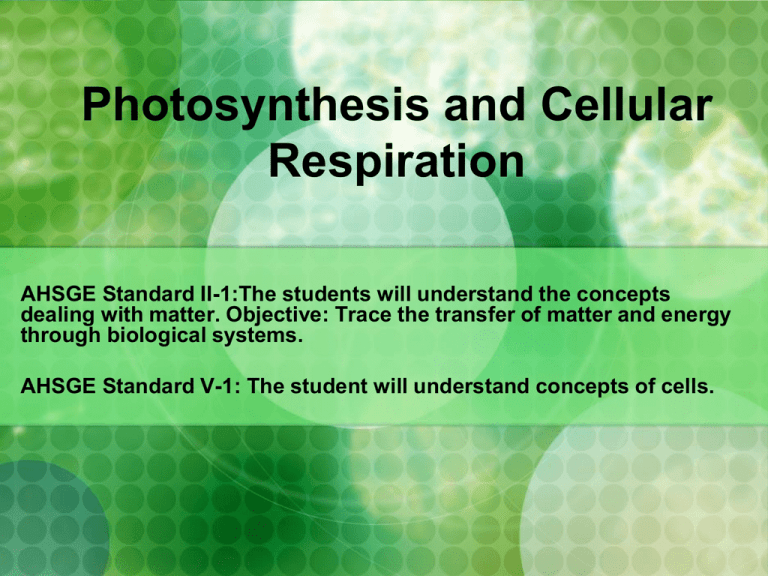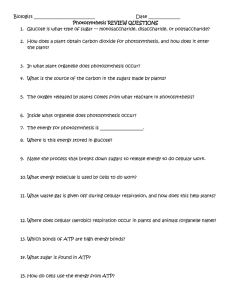Photosynthesis and Cellular Respiration
advertisement

Photosynthesis and Cellular Respiration AHSGE Standard II-1:The students will understand the concepts dealing with matter. Objective: Trace the transfer of matter and energy through biological systems. AHSGE Standard V-1: The student will understand concepts of cells. Overview In one way or another all of the energy that your body needs comes from the sun. Plants take in energy from the sun through the process of photosynthesis. Other living organism take in food and break it down to make energy through the process of cellular respiration. All of this energy flows through different organisms either through the food web or the food chain. Photosynthesis Photosynthesis is a process in which plants take in energy from the sun, carbon dioxide, and water and convert them all to make glucose (sugar), and oxygen. Photosynthesis takes place in the chloroplast of plant and algae cells and in the membranes of certain bacteria. 3 Stages of Photosynthesis 1. 2. 3. Energy is captured from sunlight. Light energy is converted to chemical energy, which is temporarily stored in ATP and the energy carrier molecule NADPH. The chemical energy stored in ATP and NADPH powers the formation of organic compounds, using carbon dioxide (CO2). Photosynthesis Formula Reactants Products 6CO2 + 6H2O---------> C6H12O6 + 6O2 Carbon Dioxide Water Glucose Oxygen OR 3CO2 + 3H2O---------> C3H6O3 + 3O2 Carbon Dioxide Water Glucose Oxygen Note: The left hand side of the formula represents the reactants and the right side the products. Photosynthesis Stage One Light Energy is Absorbed The chemical reactions that occur during the first and second stages of photosynthesis are sometimes referred to as “light reactions” or “light dependent reactions”. Pigment and Wavelengths of Light Pigments are molecules that absorbs wavelengths of light. Pigments only absorbs only certain wavelengths and reflects all others. Chlorophyll is the primary pigment that is involved in photosynthesis. Pigment and Wavelengths of Light Chlorophyll During photosynthesis the primary pigment which is chlorophyll, absorbs mostly the blue and the red light and reflects the green and yellow light. The reflection of the green and yellow light is what make plants look green. There two types of chlorophyll. You have chlorophyll A and B. Pigment and Wavelengths of Light Carotenoids Carotenoids are the yellow and orange plant pigments that aid in photosynthesis. These are the colors of most fruits, vegetables, and flowers. Carotenoids absorbs wavelengths of light differently than the chlorophyll. So, in conjunction with chlorophyll they are able to absorb more light. These pigments are located in the chloroplast of the plant cell in the thylakoid membranes. Stage II of Photosynthesis Light Energy is Converted to Chemical Energy The electron transport chain is used to pump hydrogen ions into the thylakoid (membrane inside the chloroplast). The ions will accumulate so much that they will diffuse back out of the thylakoid membrane down their concentration gradient through carrier proteins. (This is passive transport) When this happens the carrier proteins also serving as channels catalyzes (speeds up) the reaction in which a phosphate group is added to ADP (adenosine diphosphate) turning it into ATP (energy molecule). The movement of the hydrogen ions across the thylakoid membrane through the carrier proteins gives the energy needed for the third stage of photosynthesis. Stage II of Photosynthesis Light Energy is Converted to Chemical Energy While one electron transport chain is working to provide the energy needed to make ATP the second one is providing energy to make NADPH. NADPH is an electron carrier that provides the high energy electrons need to make carbon-hydrogen bonds in the third stage of photosynthesis. In this second chain the excited electrons along with hydrogen and the electron acceptor NADP+ to form NADPH. Summary of Photosynthesis STAGES OF PHOTOSYNTHESIS Used Stage 1 Light, water Stage 2 Electrons, hydrogen ions ATP, NADPH, Carbon Dioxide Stage 3 Produced Oxygen, hydrogen ions ATP, NADPH Organic Compounds Cellular Respiration Most of the foods that we eat contains energy. Before our bodies are able to use that energy it has to be first broken down into a more usable form. That energy will be in the form of ATP. The process that is used to break those foods that are high in energy down is called cellular respiration. Cellular respiration takes place in the mitochondria (powerhouse of the cell). Cellular Respiration Formula Reactants Products C6H12O6 + 6O2 ----- 6CO2 + 6H20 + energy Glucose Oxygen enzymes Carbon Dioxide Water ATP Stages of Cellular Respiration Stage 1: Glucose is converted to pyruvate helps in energy production and starts the krebs cycle. Once converted, a small amount of ATP and NADH is formed. Stage 2: When oxygen is present (aerobic) the NADH and pyruvate is used make a large amount of ATP. This is called aerobic respiration which occurs in the mitochondria of the cell for eukaryotes and in the cytoplasm (cytosol) of the prokaryotes. If oxygen is not present the pyruvate is converted to lactate or ethanol and carbon dioxide. Glycolysis In the first stage of cellular respiration glucose is broken down through a process called glycolysis ( a process that breaks down glucose into pyruvates). Cellular Respiration Summary Cellular Respiration has two stages. First glucose is broken down to pyruvate during glycolysis to make some ATP. Then a large amount on ATP is made during aerobic respiration. The Krebs Cycle is a series of reactions that produce energy storing molecules during aerobic respiration. During aerobic respiration, large amounts of ATP are made in an electron transport chain. When oxygen is not present, fermentation follows glycolysis, regarding NAD+ needed for glycolysis to continue.







